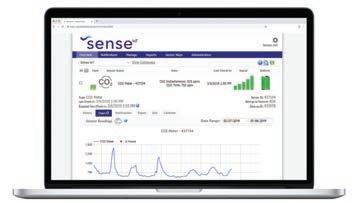
4 minute read
Hyperbaric Oxygen Treatment (HBOT
Case Study
By Kaeser Compressors
In May 2020, the Royal Hobart Hospital (RHH), Tasmania’s largest, officially opened its new Department of Diving and Hyperbaric Medicine, State Referral Centre, featuring a new stateof-the-art hyperbaric chamber which boasts a greater capacity and capability for patient treatment as well as supplying a world-class research and training facility.
Amedical hyperbaric chamber is used to deliver Hyperbaric Oxygen Treatment (HBOT), a well-known therapy for treating decompression illness, making it essential for commercial and recreational diving industries. In addition, it has been used for many years to treat patients with an array of medical conditions such as diabetic ulcers, tissue injury from radiation after treatment for cancer, osteoradionecrosis, and serious infections such as gangrene. While most patients with such conditions will heal eventually by traditional methods, a course of HBOT in addition to standard treatments, can speed up and enhance the healing process.
HBOT works by increasing the partial pressure of oxygen in the blood and tissues. The patient sits or lies in a hyperbaric chamber and is given 100% oxygen to breath via a mask or hood and the pressure is increased to 2.4 atmospheres. The high partial pressure of oxygen increases the diffusion distance that oxygen can penetrate into tissues. Repeated hyperoxic stimulation has proven to accelerate the healing process, where on average, a patient undertakes around 20 to 40 treatments over the course of four to eight consecutive weeks.
The new hyperbaric chamber at RHH was designed and engineered by Fink Engineering. A world leader in hyperbaric technology, Fink Engineering is based in Queensland, Australia and pioneered the design and development of the rectangular shape for hyperbaric chambers back in 1994 which has been used effectively ever since.
Unlike traditional cylindrical shaped and double locked hyperbaric chambers with a typical patient capacity of 2 to 5 patients, these rectangular shaped hyperbaric chambers feature a triple lock and can simultaneously treat up to 10 patients. The new hyperbaric chamber now in operation at the RHH is also fitted with capability of depressurisation to simulate altitude. There are currently only a few dual capable chambers like it in the world. A first for the southern hemisphere, this can pressurise (hyperbaric) and depressurise (hypobaric). This means that the chamber can also be used for altitude research and training using. It will be possible for researchers, for example in the aerospace sector, to study the effects of high altitude on the body, in particular, low oxygen levels and low ambient air pressure.
High quality, dry and clean compressed air is essential for a medical hyperbaric chamber to operate. Once patients have been fitted with a breathing mask or hood, the doors to the hyperbaric chamber are closed. The atmospheric pressure inside the chamber is then increased by opening values which allow high pressure air to enter.
For many years, Fink Engineering has chosen Kaeser compressed air equipment to meet these requirements and in the case of RHH, two CSD 125 T rotary screw compressors with integrated refrigerant dryers along with a comprehensive air treatment package was chosen. The hyperbaric chambers require high quality and high volumes of clean and medical breathing air that meets Australian and New Zealand standards. It is essential that the air is medical grade and clean. Staff inside the chamber breathe pressurised air while attending to patients. Patients receive hyperbaric oxygen treatment while breathing from a mask or a hood. They also breathe the hyperbaric chamber air when taking short breaks during treatment.
It is also essential that the compressed air system is reliable. Ultimately the last thing you would want is a compressor failure to stop the chamber functioning mid-
treatment which is also a reason a double redundancy system was installed. That way there is always a backup compressor, if required, to supply the compressed air needed to finish a treatment.
The CSD T series of rotary screw compressors with an integrated refrigeration dryer deliver premium compressed air quality. The latest generation of CSD systems not only deliver more compressed air for less energy, but they also combine ease of use and maintenance with exceptional versatility and an environmentally responsible design.
At the heart of every CSD system lies a premium quality airend featuring Kaeser’s Sigma Profile rotors. Flowoptimised for impressive performance, these advanced rotors help the CSD systems set the highest standards for efficiency.
Maximum performance and efficiency are further delivered thanks to the inclusion of a super premium efficiency IE4 class motor as standard. The integrated refrigeration dryer provides high-efficiency performance thanks to its energy saving control. The dryer is therefore active only when compressed air actually needs to be dried: this approach consequently achieves the required compressed air quality with maximum efficiency.
A centrifugal separator fitted with an electronic Eco-Drain condensate drain installed upstream from the refrigeration dryer ensures that condensate is reliably pre-separated and drained, even when ambient temperatures and humidity are high.
Moreover, the refrigeration dryers are equipped with R-513A refrigerant, which has a very low GWP (Global Warming Potential) value. This means that these efficient dryers will be future-proof for their entire life cycle.
The compressors were complimented with a complete air treatment package. This included Kaeser filters – the key component to produce compressed air to all purity classes as per ISO 8573-1.
Know it’s safe — anytime, anywhere.
SenseIoT provides customers with wireless monitoring systems that are designed to improve building maintenance and management.
Key features include:
• Over 50+ Types of Sensors

• HVACR Energy Management
• Custom Alerts
• Scalable Solutions
• Global Access
• MODBUS Interface
LIMITED 45-DAY TRIAL AVAILABLE












